Saffron buns made with sourdough starter and a no-knead method are perfect for winter holidays! These are inspired by Swedish lussekatter but shaped in some of the many different ways popular in Sweden.
These sourdough saffron buns are a holiday tradition, popular all across Europe. Served at Jul, Christmas, or on Santa Lucia day, depending on the shape - these are most common in Scandinavia and Italy.
Some more enriched sourdough recipes perfect for the holiday season are sourdough star bread, simple sourdough dinner rolls, and classic sourdough cinnamon rolls (try them with extra spices!).
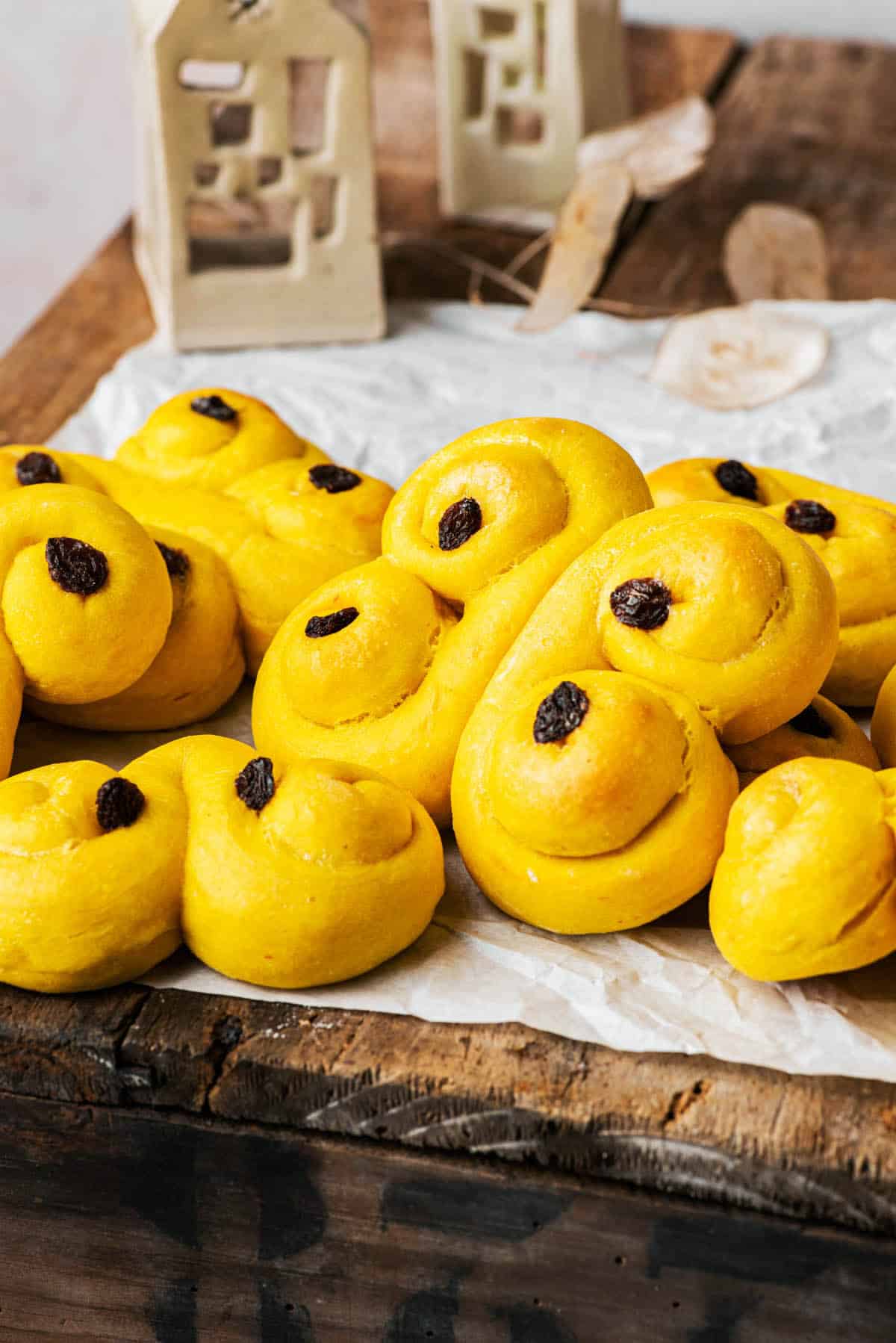
Ingredients
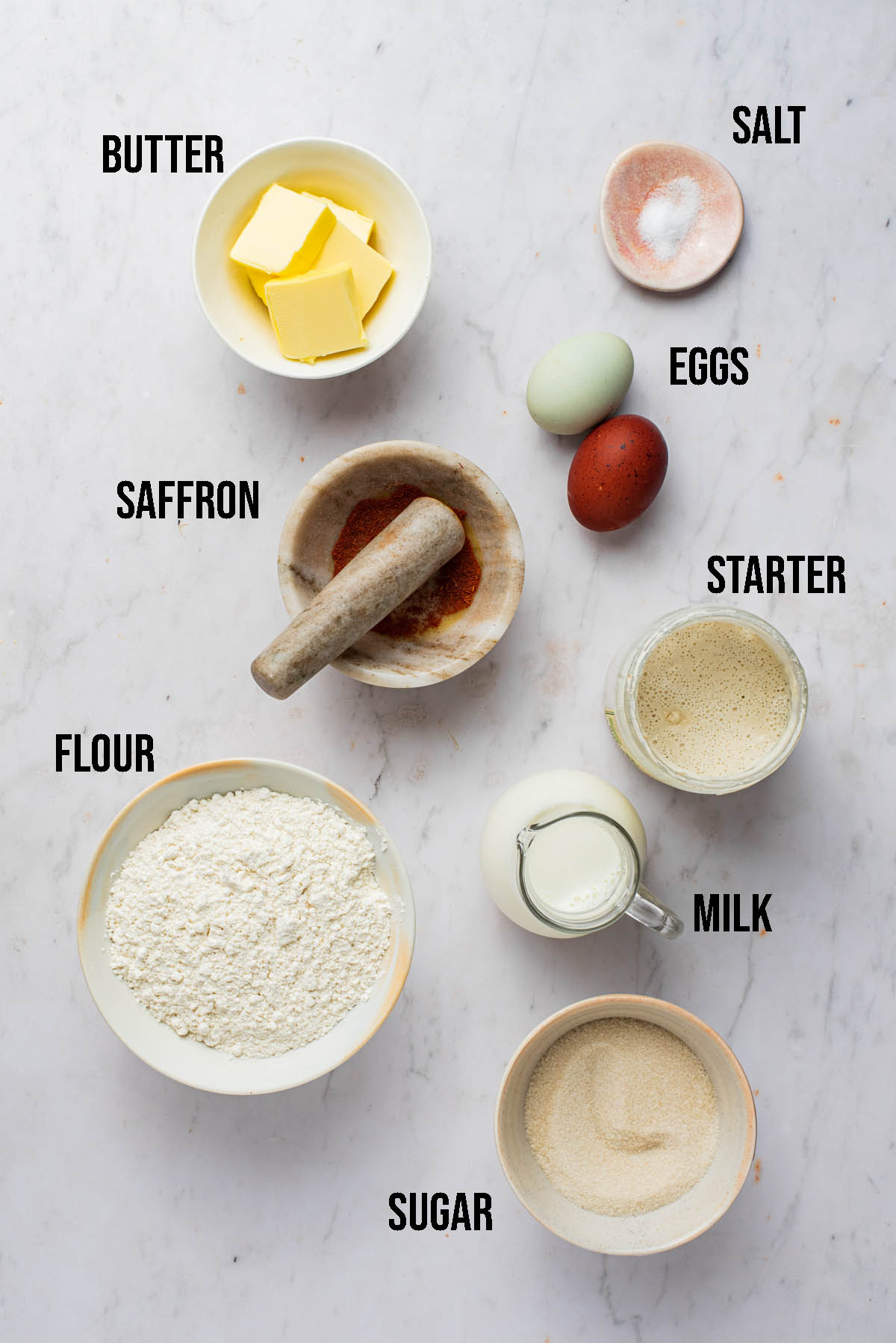
Ingredient Notes and Substitutions
- Dried fruit: the decorative raisins are optional. Try cranberries or another dried fruit if you prefer (in any case, soak beforehand).
- Add-ins: add some cinnamon or cardamom to the dough if you'd like.
- Make it dairy-free: use a good vegan butter and non-dairy milk. For a fully plant-based version, try Alex's vegan saffron buns instead.
- Flour: we haven't tried making these with bread flour, as we want to avoid any extra chewiness. If you're a beginner and find plain flour too difficult to work with, you can try using half bread flour.
Method

Step 1: heat the milk and bloom the saffron, then mix with the butter and sugar. Add the starter and egg, then mix in the dry ingredients.
Step 2: stretch and fold the dough three times.
Step 3: shape the dough into a ball and cover.
Step 4: let the dough rise until about doubled in size.
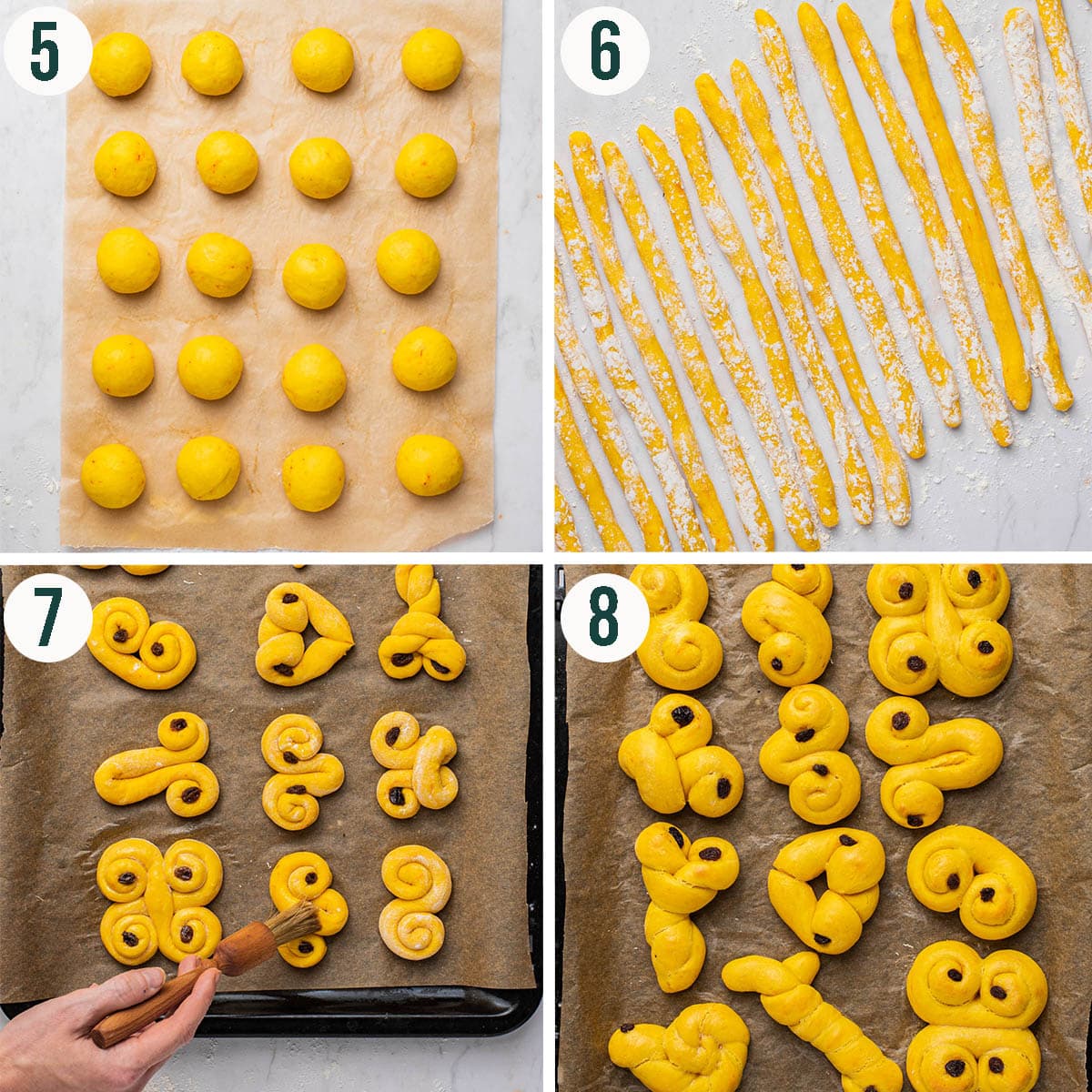
Step 5: form 20 equally sized balls of dough (weigh them for extra accuracy).
Step 6: roll the balls into long strands.
Step 7: shape into your desired bun shapes and brush with an egg wash. Add raisins for decoration if you'd like.
Step 8: bake until lightly golden and cool before serving.
Top Tips
- Don't prove twice: There's no second rise period before baking. This is because the buns lose their shape and have too great of an oven spring if they have a second fermenting period.
- Don't skip chilling: chilling makes the dough easier to shape - even if you don't want to chill overnight, we recommend doing so for at least an hour before shaping.
- Use saffron powder: grinding the saffron is key, and it's what will make for the most evenly golden, flavourful buns. If you don't have a mortar and pestle, tearing it between your fingers is fine.
Recipe Notes
Egg wash will help any complicated twists in the buns to stick, so they don't come apart during baking. There's no need to dab with water to ensure that the buns won't pull apart if you use a wash.
Be sure to use active, bubbly sourdough starter. You want it at the peak for the best result.
As usual, starting with room temperature ingredients is best. Even though the milk is being heated, avoiding cold ingredients will make for the fastest and most effective bulk proof.
FAQ
What do you eat with saffron buns?
They're perfect on their own, just sweet enough and perfectly rich. You can halve them and serve with butter or cream, jam, or any other topping you like. They're excellent with a spiced tea.
What country are saffron buns from?
While saffron buns are most often associated with Sweden, they're made all across Europe and the UK with strong traditions all the way south in Italy up to the northernmost regions of Europe.
What are saffron buns made of?
The base of the recipe will always be flour, milk, a sweetener, saffron, butter, and yeast (or sourdough starter). Some recipes will add extras like dried fruit.
If you make this Sourdough Lussekatter recipe or any other sourdough bread recipes on the Baked Collective, please take a moment to rate the recipe and leave a comment below. It’s such a help to others who want to try the recipe. For more baking, follow along on Instagram, TikTok, and YouTube.
Sourdough Saffron Buns
Equipment
- Small saucepan
- Mixing bowl
- Whisk
- Wooden spoon or spatula
- Tea towel
- Parchment paper
- baking sheet
Ingredients
- 180 grams whole milk
- ½ teaspoon saffron threads ground
- 60 grams butter room temperature
- 100 grams sugar
- 2 large eggs divided
- 100 grams active sourdough starter
- 460 grams white all-purpose flour
- 5 grams sea salt
- Soaked raisins for topping optional
Instructions
- Heat the milk and saffron in a small saucepan until just simmering.
- Add the butter and sugar to a large mixing bowl, then pour the hot milk over top. Whisk to combine, until the butter has melted.
- Check the temperature of the milk mixture. If it's just warm to the touch or cooler, then it's fine to continue. If it feels hot, wait for it to cool down.
- Divide the eggs. You need one whole egg and one egg yolk for the dough. Set the additional egg white aside for later.
- Once the milk mixture has cooled enough, whisk in the egg and yolk. Add the starter and whisk to combine.
- Add the flour and use a wooden spoon or spatula to mix until a soft, shaggy dough forms.
- Do three rounds of stretched and folds over the course of an hour, one round every 20 minutes. After this, the dough should be soft and relatively smooth.
- Place the dough smooth-side up back into the mixing bowl. Cover with a tea towel or plate, and set aside in a warm, draft-free place to rise until doubled in size. Depending on ambient temperature and the strength of your starter, this can take anywhere from 4-10 hours.
- Once the dough has risen, cover well and refrigerate for at least one hour, or up to 12hours.
- After chilling, tip the dough out onto a lightly floured surface.
- Set a large piece of parchment paper to the side of your working area.
- Divide the dough into 16 equal pieces, weighing the full dough and then each piece to ensure that they're the same size.
- Use your hand to roll each piece of dough on a clean work surface to create some tension and form round balls. Set each onto the parchment paper.
- Roll the balls into strands, about finger length, and set back onto the paper to rest while you continue rolling.
- Start with the first strand that you rolled, and roll again into long, thin strands, each about 20cm (8 in.) in length.
- Line a large baking sheet with parchment paper and preheat the oven to 350°F (180°C).
- Form the shapes that you like for each bun. Carefully place each onto the lined baking sheet and top with soaked raisins if desired.
- Brush each bun with the reserved egg white.
- Bake for 10-12 minutes, depending on the size of the buns, until golden and lightly browned.
- Cool fully before storing for up to 3 days in an airtight container. Saffron buns freeze well.


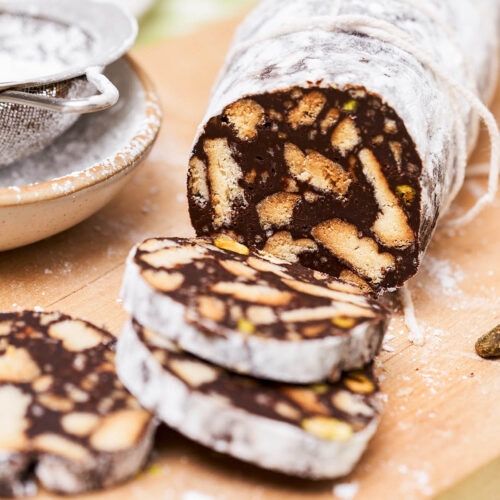
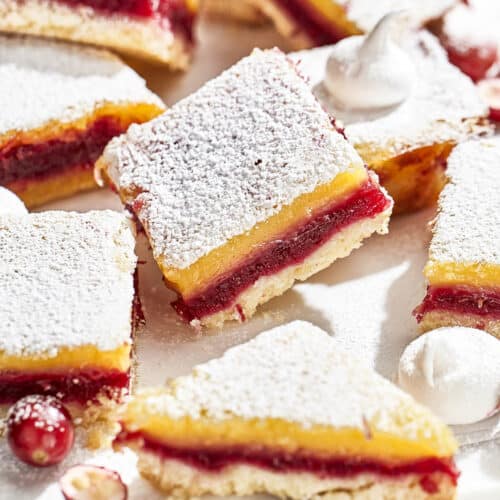

Delicious! Sweet with a delicate hint of saffron. I love that this recipe uses sourdough! My dough didn't rise very much, maybe because my kitchen is cold and my starter wasn't as active as it should have been. I just gave it more time, about 18 hours for the bulk rise. The dough was very easy to work with and shape. They didn't seem done after 12 minutes of baking so I gave them a few more, maybe 15 minutes. I will definitely make them again!